|
 Prehistoric Turkey:
(Anatolia)
Prehistoric Turkey:
(Anatolia)
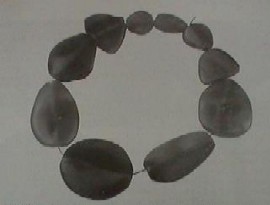

.jpg)
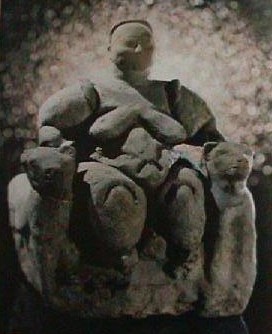
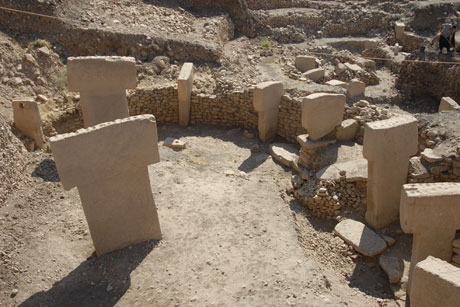
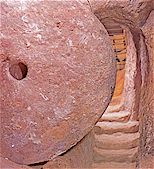
Turkey has produced some exceptional and unique
archaeological surprises that have forced us to reconsider the traditional view
of prehistory in the middle east.
For a long time, it was said
that civilisation began in Egypt but the discovery of ancient Turkish cities and industrial
complexes, combined with evidence of skills and technology, geometry and
astronomy, are revealing a very different picture from that prescribed in most
history books.
Discoveries include: The
earliest evidence of metallurgy in the world, dating at 7,200 BC. The use of
'Mud-bricks for structures at 6,500 BC.
As well as this, the
underground city at
Derinkuyu
which was connected to four other
similar sites,
creating a potential capacity of 100,000 people.
Quick Links:
|
|
 G�bekli
Tepe -
One of the most exciting discoveries in Turkish archaeology this century.
It currently stands as the oldest known Megalithic Temple complex in the
world (9,000 BC). The site has numerous intricately carved T-shaped
megaliths , covered with exquisite images if birds and animals. G�bekli
Tepe -
One of the most exciting discoveries in Turkish archaeology this century.
It currently stands as the oldest known Megalithic Temple complex in the
world (9,000 BC). The site has numerous intricately carved T-shaped
megaliths , covered with exquisite images if birds and animals.
Some of the megaliths are estimated to weigh onwards of 50-tons apiece..
(More about
G�bekli Tepe) |
|
 Nevali Cori - One of the
oldest stone temples and carved monoliths in the world. This site is now
underwater due to the creation of the Ataturk dam.
According to carbon dating, the earliest occupation of the site began at
about 8,400 BC. The settlement was continuously in use until the middle of
the sixth millennium BC. (1). Nevali Cori - One of the
oldest stone temples and carved monoliths in the world. This site is now
underwater due to the creation of the Ataturk dam.
According to carbon dating, the earliest occupation of the site began at
about 8,400 BC. The settlement was continuously in use until the middle of
the sixth millennium BC. (1).
Of the 22 buildings uncovered at Nevali Cori, only one appears to have been
used as a dwelling.
(Note:
The style of hands on the monolith (right), is similar to that found at
several early S. American sites)
(More about
Nevali-Cori) |
|
 Derinkuyu -
An 18-storey underground
complex capable of housing approximately 20,000 people.
Carved from the
living rock, Derinkuyu is one of
five
inter-connected underground complexes with a
total estimated capacity of
100,000 people. Derinkuyu -
An 18-storey underground
complex capable of housing approximately 20,000 people.
Carved from the
living rock, Derinkuyu is one of
five
inter-connected underground complexes with a
total estimated capacity of
100,000 people.
The underground complex
is multi-storey (18 storeys deep), with fresh flowing water, ventilation shafts and
individually separated living quarters or 'apartments', shops, communal
rooms, wells, tombs, arsenals and escape routes. On its own it has the potential to
house up to 20,000 people. The complex was air conditioned throughout, with
52 air shafts discovered so far.
(More about Derinkuyu)
|
|
 Ashikli Huyuk -
Evidence of sophisticated technology dating to 7,500
BC. Ashikli Huyuk -
Evidence of sophisticated technology dating to 7,500
BC.
This
remarkable necklace (right), was uncovered in 1989. It is made of burgundy agate and
consists of ten polished beads all shaped between 2.5 cm and 5.5 cm in
length and perforated longitudinally no more than 7-8 mm diameter, even
though agate is 7 on the Mohs' scale of hardness.
(The necklace is dated to between 7,500 BC and 7,000 BC).
To drill similar holes today requires the use of a highly specialised
diamond-tipped tungsten-carbide drill. (1)
Regardless
of the technical difficulties of perforating the stones, the presence of
such early technology, expertise and craftsmanship does
not appear overnight but is developed over many years, suggesting an even
earlier origin to develop the required skills.
(More
about Ashikli Huyuk) |
|

Catal Huyuk -
One of the earliest known 'cities' in the world dating back to 6,800 BC.
Several 'shrines' including some of the clearest evidence of
'earth-mother-goddess' worship and both bull and vulture veneration.
Cultural suggestion of links to both proto-Egyptian and Sumerian
cultures. This city, along with several other 'Metsamorian
town-ships' from
the same time has radically changed our thinking of development in the
middle east.
(More about Catal Hoyok)
(More about the Earth-Mother-Earth goddess) |
 �ay�n�
-
Metallurgy, beads and human sacrifice at 7,200 BC.
�ay�n�
presents certain discoveries that cause us to rethink our prehistoric past.
The site
contains a large number of rectangular
stone buildings,
laid out in a grid-plan formation, as at
Nevali Cori.
Many of the buildings show evidence of having had special functions, for
example, the 'Flagstone' building has a floor made
entirely from large flagstones into which were
set megalithic stones. �ay�n�
-
Metallurgy, beads and human sacrifice at 7,200 BC.
�ay�n�
presents certain discoveries that cause us to rethink our prehistoric past.
The site
contains a large number of rectangular
stone buildings,
laid out in a grid-plan formation, as at
Nevali Cori.
Many of the buildings show evidence of having had special functions, for
example, the 'Flagstone' building has a floor made
entirely from large flagstones into which were
set megalithic stones.
Includes the 'Skull' building' -
A structure
7m x 7.9m in size with a round asp at one end. In two small
ante-chambers, archaeologists unearthed roughly 295 skulls. A large chamber was also discovered that
contained a one-ton cut and polished stone block, which, along with the
discovery of a large flint knife makes it almost certain that the stone
acted as an 'offering table'.
(More about Cayonu) |
|
 Troy (Illium) - The long believed mythological city of Homers
Illiad revealed. Troy (Illium) - The long believed mythological city of Homers
Illiad revealed.
The city of Troy was finally
discovered in 1870 after a lifelong quest by Dr. Harold Schliemann.
In return for his vigilance,
he found the so called 'Priam treasures'
which he late confessed to smuggling out of Turkey with his wife and
'...sadly all but one pair
of earrings and a few other small objects disappeared from Berlin in
1945' (2).
(More about Troy, Illium) |
Armenia.
(Armenia became officially recognised in 1991)
|
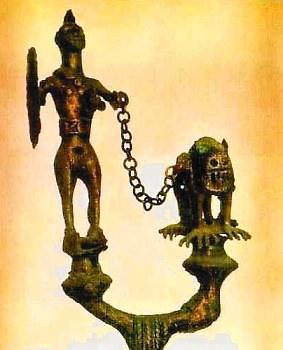 Metsamor
(Armenia since 1991) -
Metsamor is a working excavation and museum on the site of an
ancient city
complex with a large metallurgical and astronomical centre (occupied ca.
7,000 BC - 17th c. CE). The site occupies a volcanic hill and surrounding
area. Metsamor
(Armenia since 1991) -
Metsamor is a working excavation and museum on the site of an
ancient city
complex with a large metallurgical and astronomical centre (occupied ca.
7,000 BC - 17th c. CE). The site occupies a volcanic hill and surrounding
area.
The astronomical observatory
predates all other known observatories in the ancient world. That is,
observatories that geometrically divided the heavens into constellations and
assigned them fixed positions and symbolic design. Until the discovery of
Metsamor it had been widely accepted that the Babylonians were the first
astronomers. The observatory at Metsamor predates the Babylonian kingdom by
2000 years, and contains the first recorded example of dividing the year
into 12 sections. Using an early form of geometry, the inhabitants of
Metsamor were able to create both a calendar and envision the curve of the
earth.
(More about Metsamor) |
|
Prehistoric Turkey in the News: |
The Earliest Evidence of the Wheel:
Recent discoveries in the southeastern
province of Mardin in Turkey have revealed what are currently
the oldest examples of the wheel in the world. Until recently,
it was believed that the Sumerians
were the inventors of the wheel, with examples dating back to c.
3,700 BC, but the discovery of a stone-carved 'toy' wheeled
vehicle dating back to c. 5.500 BC adds to the list of cultural
'first's' now being shown to have originated in this area long
before the Sumerian or Egyptian cultures existed.

The earliest example of a wheeled vehicle in
the world c. 5,500 BC, now on display in the Mardin Museum,
Turkey.
(Link
to Full Article)
Article:
'Lost Civilisation under Istanbul'.
(Feb. 2009).
Recent excavations in Istanbul, have uncovered remains dating back to
6,000 BC. The vase that the cremated remains were found in shows
similarities with nearby Anatolian cultures.
(Link
to National Geographic Article)
|
List and Description of Featured Turkish Sites: |
Turkey.
|
Ashikli H�y�k |
|
Evidence of sophisticated
technology dating to 7,500 BC |
|
�atal H�y�k |
|
City dating back to 6,800 BC.
Numerous interesting artefacts. |
|
�ayonu |
|
Metallurgy, beads and
human sacrifice at 7,500 BC. |
|
Derinkuyu |
|
An 18-storey
underground complex capable of housing approximately 20,000 people. |
|
G�bekli Tepe |
|
Earliest known temple complex in history.
50-ton carved stones. |
|
Nevali Cori |
|
One of the
oldest stone temples and carved
monoliths in the world. |
|
Troy |
|
The long believed mythological city of
Homers Illiad. |
Armenia.
|
Metsamor |
|
Megalithic complex with
advanced astronomy and geometry. |
|